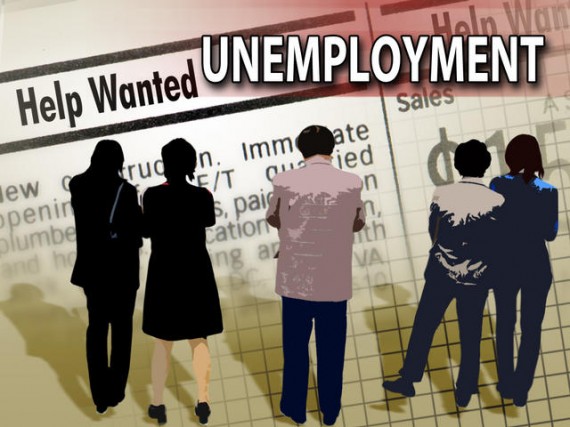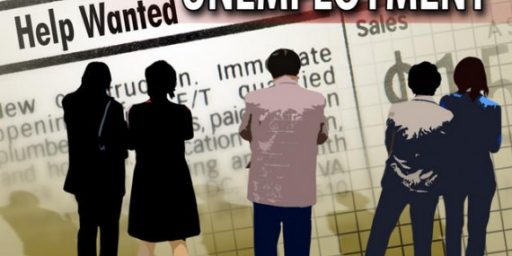Unemployment Worse than 1982
Age-adjusted unemployment is at its worst in more than a quarter century
David Rosnick at the Center for Economic and Policy Research argues that after adjusting for the age of the population the unemployment situation with the current recession is worse than in 1982.
A naïve examination of the raw unemployment rates would suggest that the downturn of the early 1980s resulted in a labor market even weaker than what we have experienced as a result of the collapse of the housing bubble. However, the demographics of the labor force have changed significantly over the last quarter century. Most importantly, the labor force has grown older since the early 1980s. This is important in considering the unemployment rate over time, as younger workers are much more likely to be unemployed than older workers.2
[…]
As the labor force ages, we should expect unemployment to fall. Older workers have more experience, and, once out of school, find longer-term employment. As seen in Figure 2, unemployment is skewed heavily toward younger workers. While the average unemployment rate among those under 20 is more than 15 percent, the rate for those 35 and over is less than 5 percent.
In other words, if the labor force today is comprised of more workers who are “older” than in 1982 then we can consider an unemployment rate today worse than in 1982 since we’d expect unemployment to be lower anyways. Or another way of stating it is that raw unemployment numbers (e.g. ignoring for age of the labor force) makes comparisons of numbers from different time periods problematic.
Rosnick then breaks down the 12 month average unemployment rate by age group and has found that the unemployment rate with this recession is higher across all age groups than in 1982.
After adjusting for the aging of the population since the early 1980s, the current labor-market downturn has resulted in both a higher unemployment rate and a longer period when the rate of unemployment remained over 10 percent. The unemployment rate peaked in December of 1982 at 10.9 percent, yet fell to 9.9 percent by June of 1983. For seven months, the rate of unemployment held at over 10 percent. On the same age-adjusted basis, the unemployment rate has been over ten percent for thirteen consecutive months, including five months over 11.0 percent and reaching 11.2 percent in October of 2009. Over the last twelve months, the rate of unemployment has never fallen below 10.8 percent.
H/T David Leonhardt






I’m not quite understanding exactly what the reasoning is behind making this adjustment? He states right off the back that the work force is in general is older than in the 1980s, so it stands to reason that more older people will be out of work. It doesn’t change any actual numbers.
It is more tragic on a social level because the older person unemployed has much more difficulty making up potential lost wages and fewer prospects for new employment. It may also provide hints where we need to focus job creation (in skilled position as opposed to entry level).
I”m not sure I follow the age thing either, but I did see this:
“Reversion To 10 Year Average Labor Force Participation Rate Implies 11.8% Unemployment Rate”
http://www.zerohedge.com/article/reversion-10-year-average-labor-force-participation-rate-implies-118-unemployment-rate
I don’t really know if that reversion is a safe assumption, given the aging population, but we should see at least some retracement.
Don’t expect the Baby Boomers who have jobs to let go of them any time soon. Indeed, I won’t be surprised if some number who’ve retired or otherwise left the labor market return.
Savings have been low to non-existent for decades. Stock portfolios and 401Ks are dwindling in value. So are houses. They may not have much choice. People who ten years ago were thinking about retiring to a beach house somewhere may be more likely to work an additional five or ten years now.
Unemployment tends to be a younger worker problem, not an older worker problem. So during a recession you expect more unemployment amongst the younger portion of the labor force. Today our labor force has younger workers as a considerably smaller protion of the work force. So if you “normalize” for age, the current unemployment rate is actually higher.
Or just look at where he has compared the 12 month average unemployment rate across age groups, this time around unemployment is worse across all age groups than in previoius recessions. But becuase we have fewer “young workers” our overall unemployment rate doesn’t look as bad as 1982.
It seems to me that the fact that the work force got older already normalizes for age and by making the adjustment you are overcompensating. If the work force broke down into the same percentages by age group and the unemployment was higher in the older age brackets that may warrant an adjustment… a more meaningful measurement might be some sort of measurement of skill level of the unemployed.
But this is your area and not mine, so you are the expert. Other than Dave S’s comment how does it change the overall picture?
No c.red, the aging of the population changes the make up the labor force thus making inter-temporal comparisons suspect without the adjustment. You keep getting it backwards.
All unemployment figures are suspect. An adjustment just assumes some things, trying to look at other things.
If we were going to try to adjust for the losses Dave talks about, we’d have to adjust for net worth.
Or, as I think I’ve suggested in the past, just skip the unemployment numbers, and just look at changes to net worth. If the 40-50 year old cohort is richer than it used to be, then regardless of employment, they are doing better. If it is poorer … even with increased labor participation, then things are bad.
The sketchy thing about employment is that we don’t know if job seekers are trying to pay for a European vacation, or just to eat.
In all of my job search and networking groups, rarely is there an unemployed person under 35! Anecdotal, I know, but rampant age discrimination in hiring is all I am hearing about.
c. red, I feel your pain. I’m not sure that I get it either.
Steve V, does this analsysis suggest a larger problem with structural unemployment, with more experienced workers unemployed it may be difficult for them to return to the work force, whereas a younger work may have greater ability and time to refit?
How does the outsourcing of jobs effect these figures? We didn’t have that phenomenon in the 80s. (I expect it to exacerbate the unemployment rate.)
PD,
That is interesting, I hadn’t considered it, but given that right now the view is that unemployment will likely remain high for some time (i.e. lag the business cycle considerably) yes that might very well be the case.
sam,
Outsourcing has always been with us, outsourcing is a function of reducing costs and nothing more.
http://en.wikipedia.org/wiki/Outsourcing
“Outsourcing has always been with us, outsourcing is a function of reducing costs and nothing more”
Yeah, but Steve what I’m talking about here is offshoring — the sending of US jobs overseas. Does anyone know the effect of that on the overall unemployment rate?
PD – that was where I was trying to go, so thank you for stating it more clearly.
Steve V, did you read that Andy Grove piece?
Andy’s saying those 10:1 ratios haven’t “always been with us.”
http://www.bloomberg.com/news/2010-07-01/how-to-make-an-american-job-before-it-s-too-late-andy-grove.html
sam,
Offshoring is a subset of outsourcing so I don’t see a big deal, and it too has been around for a long time.
So what, I don’t see the point. You think that if you tell Apple not to set up shop in China those jobs will come here? I seriously doubt it.
Why is it all the numbskulls always focus on China and other countries? Racism? Parochialism? What? Everyone focuses on that but ignores that technology is the biggest destroyer of jobs. Want to create jobs via this route? Kill Apple, Dell, and the internet. Destroy everyother PC and fax machine. Add in copiers while you are at it too. The term computer actually applied to people for crying out loud. Rooms full of people would do the computing for various projects…they were the computers. With the advent of the modern computer all those jobs were destroyed. Replaced by machines. Why not augment your fear of the “other” with neo-ludditism?
250,000 jobs….not even enough to provide a single months good non-farm payroll numbers…..and we are going to obsess on that?
I think my comment was primarily observational, and not normative.
You jump rather quickly to dangerous responses to the problem, perhaps because you don’t want to pause to consider those structural aspects of unemployment in an aging US workforce, facing global competition.